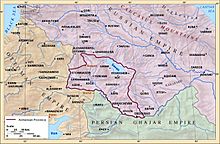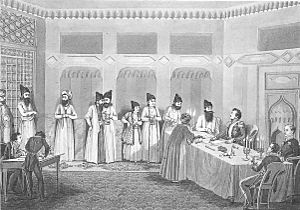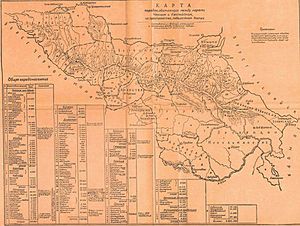Armenian Oblast facts for kids
Quick facts for kids
Armenian Oblast
Армянская область
|
|
|---|---|
|
Oblast
|
|

Map of the Armenian Oblast
|
|
| Country | Russian Empire |
| Viceroyalty | Caucasus |
| Established | 1828 |
| Abolished | 1840 |
| Capital | Erivan (Yerevan) |
| Area | |
| • Total | 31,672 km2 (12,229 sq mi) |
| Population
(1832)
|
|
| • Total | 164,500 |
| • Density | 5.1939/km2 (13.452/sq mi) |
The Armenian Oblast was a special area (called an oblast) that was part of the Russian Empire. It existed from 1828 to 1840. This region covered most of what is now central Armenia. It also included parts of modern-day Turkey (the Iğdır Province) and Azerbaijan (the Nakhchivan area). Its main city and capital was Yerevan, which was known as Erivan back then.
Contents
History of the Armenian Oblast
The Armenian Oblast was created after a big war between Russia and Qajar Iran (the Russo-Iranian War of 1826-1828). Russia won this war and gained control of two areas, the Erivan and Nakhchivan khanates. These areas then became the Armenian Oblast in 1828.
Ivan Paskevich, a famous Russian military leader who helped win the war, was given the special title "Count of Erivan." Russian leaders wanted to reward Armenians who had helped Russia during the wars. They also believed that Christian people like Georgians and Armenians would prefer Russian rule over the many Muslims in the Caucasus region.
Even though Russia took over, they mostly kept the old ways of running the area. Many Muslim leaders were allowed to continue their jobs. Some even became deputy governors, working with the Russians. Since Iran was no longer a threat, the Russian government in Saint Petersburg and the local Russian leaders in Tiflis (Tbilisi) didn't pay much attention to the Armenian Oblast.
In 1829, a German explorer named Friedrich Parrot visited the region. He was part of an expedition to climb Mount Ararat. He was joined by an Armenian writer named Khachatur Abovian. Together, they made the first recorded climb of Mount Ararat from the Armenian monastery of St. Hakob.

Over time, Armenians and some Russian officials complained about how the Muslim leaders in the province were running things. So, in 1840, the Russian government made a new rule. It said that all local laws and customs had to be stopped. All official business had to be done in Russian, and only Russians could work in government offices. At the same time, the Armenian Oblast was no longer a separate area. It was combined into a new, larger region called the Georgian-Imeretian Province.
This new setup didn't last long. By 1844, the Russian government wanted to strengthen its control over the Caucasus. They brought back the Caucasus Viceroyalty. The area that used to be the Armenian Oblast became part of the Tiflis Governorate. Then, in 1849, the Erivan Governorate was created. This new area was separate from the Tiflis Governorate and included the lands of the old Erivan and Nakhchivan khanates.
People of the Armenian Oblast
Population Changes
After the Russian-Iranian War of 1826-1828, Russia combined the Erivan and Nakhichevan areas into the new Armenian Province. Before Russia took over, most people in these areas were Muslim. For example, in the Erivan Khanate, about 71.5% of the people were Muslim, and 28.5% were Armenian. In the Nakhichevan Khanate, about 83% were Muslim, and 17% were Armenian. Overall, before the Russians arrived, about 75% of the people in these combined areas were Muslim, and 25% were Armenian.

For a long time, Armenian leaders in Russia and Georgia had wanted Russian help to free their people from Muslim rule. During the peace talks after the war, a special rule (Article XV) was added to the Treaty of Turkmenchay. This rule allowed any Iranian person to move freely into the Russian Empire within one year. They could also sell their property without any extra taxes. This rule was mainly for Armenians whose families had been forced to move to Iran many years ago. The Russians even encouraged Armenians to move by spreading announcements and sending soldiers to persuade them.
New Population Numbers
From 1828 to 1831, about 35,560 Armenians moved from Iran into the Armenian Oblast. This area soon became known as Russian Armenia. By 1831, another 21,666 Armenians moved from parts of the Ottoman Empire (like Bayazid and Kars) into the Armenian Oblast. Some sources say that a total of 40,000 Armenians came from Iran and 90,000 from the Ottoman Empire.
By 1832, Russian records showed there were 82,377 Armenians in the Armenian Oblast. Also, about 7,813 Muslim nomads who had left during the war returned. This made the total Muslim population 82,073. So, in 1832, the total population of the Armenian Oblast was about 164,450 people. Armenians made up about 50.09% of the population, and Muslims made up about 49.91%. This meant that Armenians had finally reached almost equal numbers with Muslims in part of their historical homeland.
Most of the Muslims in the Armenian Oblast were Shia Muslims. The Russians called the Turkish-speaking Muslims "Tatars." These "Tatars" later became known as "Azerbaijani" after 1918.
Administration
There were not many Russian officials in the Armenian Oblast. They often relied on the Muslim administrators and interpreters who had worked for the Iranians before. Things like land ownership, taxes, and the court system mostly stayed the same. The Persian language or the local Turkish language continued to be used in many government offices.
Literature
- A Journey to Arzrum, Alexander Pushkin, 1835–36
- Wounds of Armenia, Khachatur Abovian, 1841
See also
 In Spanish: Óblast de Armenia para niños
In Spanish: Óblast de Armenia para niños
- Russian Armenia
- Erivan Governorate
- History of the administrative division of Russia


